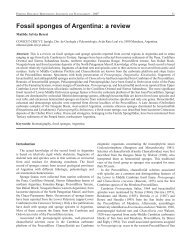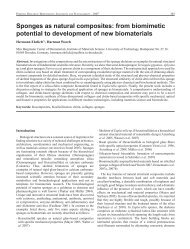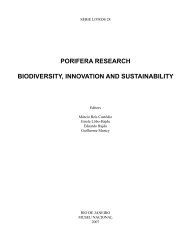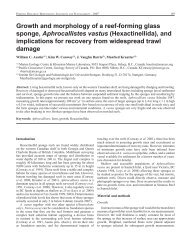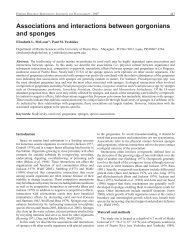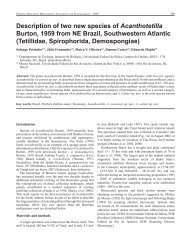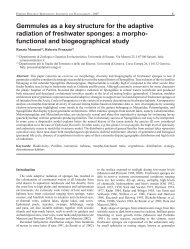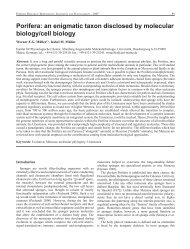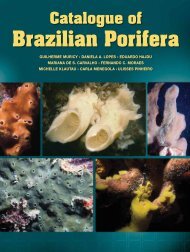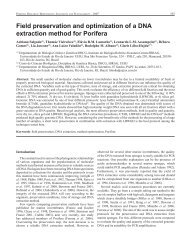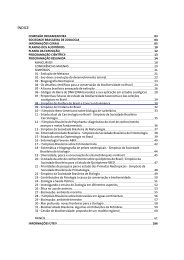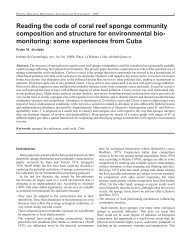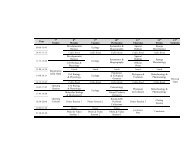Volkmer-Ribeiro - South American continental ... - Porifera Brasil
Volkmer-Ribeiro - South American continental ... - Porifera Brasil
Volkmer-Ribeiro - South American continental ... - Porifera Brasil
- No tags were found...
Create successful ePaper yourself
Turn your PDF publications into a flip-book with our unique Google optimized e-Paper software.
<strong>Porifera</strong> Research: Biodiversity, Innovation and Sustainability - 2007117<strong>South</strong> <strong>American</strong> <strong>continental</strong> sponges: state of theart of the researchCecília <strong>Volkmer</strong>-<strong>Ribeiro</strong>Museu de Ciências Naturais, Fundação Zoobotânica do Rio Grande do Sul. Rua Dr. Salvador França, 1427. 90690-000,Porto Alegre, RS, Brazil. Research fellow of CNPq. cvolkmer@fzb.rs.gov.brAbstract: An intensive survey and study of the <strong>South</strong> <strong>American</strong> freshwater sponges started around four decades ago. A largenumber of results came out which now allows a first overview. An outstanding number of new species of freshwater spongesand even new genera were described. The new materials presented remarkable differences when compared with speciesfrom the other continents. This new sponge <strong>continental</strong> fauna has ever since been subjected to constant checking due tocontinued and extensive surveys, redescriptions and habitat descriptions. The diversity of the <strong>South</strong> <strong>American</strong> sponge faunais remarkable being possibly the richest in the world. All the review efforts dedicated to this branch of Demosponges areenhancing confidence in the perception of how thrustworthy some characters are and how much their degree of variation islinked to specific habitats, thus enabling the application of this taxonomic knowledge.Keywords: Continental sponges, research, <strong>South</strong> America, state of the artBuild and rebuild your softwareEvolution has been the main word leading the researchof all of us as biologists and naturalists in our efforts tounderstand how living beings have organized themselves andhow living processes of all sorts play around us. Lately, withthe growing success of replicating life in our labs, evolutionincludes the idea of how we are setting up life around theworld and even around the planetary system. One but not theleast of the resulting consequences is that taxonomists arebeing urged to come up with applied propositions stemmingfrom their taxonomic research. This taxonomic perfectioningtakes place and weight as our scientific life goes by andparticularly if it stays long enough as that of a large numberof us has been staying. Looking back and forth becomes adaily routine with special emphasis on ideas, hypotheses andconclusions, challenged by every new evidence, findings andreading. One starts with grain-size evidences, cements themtogether, builds up his/her initial operating system and fromthen on builds and rebuilds oneself’s rationale. Plain commonsense, but a painful process… And here it is when Scienceturns into Art and Philosophy. Into art because a scientist´salways present inquiring impulses are driven by a desire tograsp and reproduce the perfection offered by Nature. Intophilosophy because only this endeavour will heal the humanmind in its failure to reach that goal.The gains of the <strong>continental</strong> approachA whole new <strong>continental</strong> fauna of Demosponges, that ofthe <strong>South</strong> <strong>American</strong> continent, was disclosed mainly overthe last half of the 20 th century. This <strong>continental</strong> fauna maybe comparable in importance to the findings of fossil marinesponge faunas preserved in rocky outcrops which latelyemerged as <strong>continental</strong> areas. The main difference betweenthese lies on the fact that those marine faunas are a snapshot ofthe past and not an ongoing movie as the present <strong>continental</strong>sponge faunas are. And, as such, research on <strong>continental</strong>sponge faunas benefits from playbacks whenever collectingsites are re-visited to check hypotheses, improve descriptionsand study niches (niche sensu Hutchinson 1967).But more than offering easy access to previous collectingsites, <strong>continental</strong> sponge faunas offer the chance tostudy biological/ ecological (adaptation),versus geologic(phylogeny) evolution, when <strong>continental</strong> drift is consideredand <strong>continental</strong> plates are understood as analogous to hugeislands. A large isolation degree in respect to time and spacecausing easier determination and follow up of geographicbarriers and vicariance effects (Nelson and Platnick 1981)appears then as important aspects to drive the search forevolving characters in these <strong>continental</strong> Demosponge faunasaiming to the perfection of species identification, the detectionof endemisms and the estimation of the time consumed alongall these processes. All such aspects are obviously harder todetect when marine demosponges are considered.Three main realms should be in fact considered in whatrespects sponges: the marine, the epi<strong>continental</strong> and the<strong>continental</strong> one. The first and third ones need no furtherexplanation. The second one has to do with those seas in theprocess of <strong>continental</strong> enclosure, so turning into brackish andthen fresh water. This epi<strong>continental</strong> marine fraction of thepresent world waters has seldom been surveyed for sponges,in spite of the fact that other phyla were studied in detail andseen to pass by a drastic reduction in biodiversity, like, forinstance the Echinoderms in the Baltic Sea (Hutchinson 1967).The presently known rich marine versus poor freshwater
118poriferan biodiversity (Hooper and van Soest 2002) certainlyallows for the expectation that the present epi<strong>continental</strong>sponge faunas may also offer very interesting and intriguingselection processes and local extinctions prior to adapting tofreshwater.Continental surveying of an unknown sponge faunaThe first descriptions of <strong>South</strong> <strong>American</strong> <strong>continental</strong>sponges were produced in the 19 th century and were basedon a few specimens gathered in the Orinoco, Amazon andUruguay Rivers by foreign explorers and deposited mainlyin English and German Museums. The next main taxonomicefforts date to the middle of the last century, when Bonettoand Ezcurra de Drago started to survey the Argentinean<strong>continental</strong> sponges (Ezcurra de Drago 1971) and <strong>Volkmer</strong>-<strong>Ribeiro</strong> the Brazilian ones (<strong>Volkmer</strong>-<strong>Ribeiro</strong> 1981) resultingat present in a number of twenty nine new species, six newgenera and one new extant family described, plus one newfossil species and family defined. At this time significantfreshwater sponge collections were initiated by these authorsat respectively the Instituto Nacional de Limnologia - INALI,Santa Fé, Argentina and the Museu de Ciências Naturais,Fundação Zoobotânica do Rio Grande do Sul, Rio Grandedo Sul, Brazil.Bonetto and Ezcurra de Drago as well as <strong>Volkmer</strong>-<strong>Ribeiro</strong>initially faced a confusing situation in what respected thetaxonomy of the world’s freshwater sponges long ago splitby Carter´s taxonomic proposals (Jewell 1952). The problemwas however overcome due to the remarkable differencesthat the new materials presented when compared with thedescriptions available for the species already known. In thatway an outstanding number of new species was describedwhich is resisting the continued studies and surveys that arebeing carried out until the present. The appearance of Penneyand Racek’s (1968) comprehensive revision of the world’sfreshwater sponges offered next a sound basis for revisionalstudies of species and genera and proposition of newgenera. The master lines established by Penney and Racekwere followed by both of the authors, <strong>Volkmer</strong>-<strong>Ribeiro</strong> andEzcurra de Drago, resulting in the validation and enlighteningof prior proposals for diverse <strong>continental</strong> sponge genera byGray (1867), according to detailed redescriptions (<strong>Volkmer</strong>-<strong>Ribeiro</strong> and De Rosa-Barbosa 1972, <strong>Volkmer</strong>-<strong>Ribeiro</strong> 1984,<strong>Volkmer</strong>-<strong>Ribeiro</strong> and Costa 1992, <strong>Volkmer</strong>-<strong>Ribeiro</strong> andTavares 1995, Tavares and <strong>Volkmer</strong>-<strong>Ribeiro</strong> 1997) of newmaterials with <strong>South</strong> <strong>American</strong> species, which had been onlybriefly described before.Two neighboring <strong>continental</strong> platesA milestone mark at this point was the study of the EdwardPotts´ collection of type materials of the species he describedfor the United States and Canada (Potts 1887) and depositedat the Academy of Natural Sciences of Philadelphia (<strong>Volkmer</strong>-<strong>Ribeiro</strong> and Traveset 1987). That collection had not beentaken in consideration by Penney and Racek (op. cit.). Theidea was that comparative descriptions of species restrictedto the Nearctic/Neotropical regions would favor any futurevicariance studies due to the vicinity of the North and the<strong>South</strong> <strong>American</strong> <strong>continental</strong> plates. In this way genera withexclusive Nearctic-Neotropical distribution came into lightsuch as Corvomeyenia Weltner, 1913 (<strong>Volkmer</strong>-<strong>Ribeiro</strong> etal. 2005) and Anheteromeyenia Schröder, 1927 (<strong>Volkmer</strong>-<strong>Ribeiro</strong> 1986a), or with predominant occurrence in these twocontinents like Racekiela Bass and <strong>Volkmer</strong>-<strong>Ribeiro</strong>, 1998(Bass and <strong>Volkmer</strong>-<strong>Ribeiro</strong> 1998).One genus and five <strong>continental</strong> plates drifted apartThe continued concern with the search for trustworthydiagnostic specific characters present in dried preservedmaterials (so that comparative studies could keep onencompassing old preserved materials) was deepened nextwith the revision of Metania Gray 1867, which has a tropicaldistribution. Such an effort sprung from the large number ofspecimens of this genus collected particularly in the Brazilianand Venezuelan Amazonia. At this time the search for whatwould become trustworthy diagnostic characters for speciesidentification was centered on the large isolated spongefaunas at the plates of <strong>South</strong> America, Africa, Australia,India and Indonesia split from Gondwana and drifted apart.The resulting study brought to attention the existence of agondwanian fauna of freshwater sponges (<strong>Volkmer</strong>-<strong>Ribeiro</strong>1986b, <strong>Volkmer</strong>-<strong>Ribeiro</strong> and Costa 1992, 1993, Silva and<strong>Volkmer</strong>-<strong>Ribeiro</strong> 2001), which <strong>Volkmer</strong>-<strong>Ribeiro</strong> and DeRosa-Barbosa (1979) had already indicated by extending theoccurrence of the family Potamolepidae from the Ethiopianto other gondwanian plates. An array of characteristics cameto light again which confirmed Gray´s (1867) insight ofthe value of gemmoscleres, microscleres and the gemmulestructure for the definition of genera and species.Timing the birth of a <strong>continental</strong> sponge faunaAlso, from the studies on Metania it was possible for thefirst time to envision the time elapsed in attaining speciationand generic diversification for a group of <strong>continental</strong> spongesi.e. the Cretaceous drifting apart of the Gondwanian plates.Given the established paradigm that geologic time scales arethose required to produce measurable change, particularlyof gemmosclere’s and microsclere’s shape and size, as wellas on number of spicule categories present, a continuedrevisional effort was extended to all genera of <strong>South</strong> <strong>American</strong><strong>continental</strong> sponges, allowing a more confident redefinitionof monospecific genera (Acalle, <strong>Volkmer</strong>-<strong>Ribeiro</strong> and DeRosa-Barbosa 1972, Uruguaya and Sterrastrolepis, <strong>Volkmer</strong>-<strong>Ribeiro</strong> and De Rosa-Barbosa 1979, and the recognition of newgenera (Oncosclera <strong>Volkmer</strong>-<strong>Ribeiro</strong>, 1970, Saturnospongilla<strong>Volkmer</strong>-<strong>Ribeiro</strong>, 1976, Corvoheteromeyenia, Ezcurra deDrago, 1979, Racekiela Bass and <strong>Volkmer</strong>-<strong>Ribeiro</strong>, 1998) aswell as the description of new species, among which thosewhere monospecific genera descriptions had been based on:Saturnospongilla carvalhoi, Sterrastrolepis brasiliensis.At present the largest number of records in the <strong>South</strong><strong>American</strong> freshwater sponges are from Brazil and Argentinabut reports have also been produced for Suriname (Ezcurra deDrago 1975), Venezuela (Bonetto and Ezcurra de Drago 1973,<strong>Volkmer</strong>-<strong>Ribeiro</strong> and Pauls 2000), Chile (Ezcurra de Drago1974, Kilian and Wintermann-Kilian 1976) and Uruguay
119(Berroa Belén 1968). The <strong>South</strong> <strong>American</strong> <strong>continental</strong> platehas so been crossed from north to south and east to westleading to the idea that a large number of habitats has yetto be surveyed for <strong>continental</strong> sponges in this remarkablydiverse continent. Now, quite a different picture has emergedof this <strong>South</strong> <strong>American</strong> fauna showing that it is one of therichest, if not the richest in the world.Applied sponge taxonomyContinuous checking of habitat characteristics versusspecies occurrence is a tool never discarded by specialists intheir search for the confirmation of a species status and thedescription of ecomorphic variations of characters (<strong>Volkmer</strong>-<strong>Ribeiro</strong> 1973, Poirrier 1974). The performance of the abovementionedprocedures, besides submitting species and generato constant revisional efforts generates confidence in speciesdefinitions and provides a series of applications for thistaxonomic knowledge.The first concerns the monitoring of freshwater habitatswith respect to the integrity of their biodiversity or theirrestoration with environmental recovering practices. Theknowledge now available encompasses the detection ofseveral sponge assemblages in some typical <strong>South</strong> <strong>American</strong>habitats, such as Coastal ponds, lakes and lagoons (<strong>Volkmer</strong>-<strong>Ribeiro</strong> and Machado 2007), Cerrado (Savannah) pondswhere an assemblage of five species thrive or where theyformed spongillite deposits in the past (<strong>Volkmer</strong>-<strong>Ribeiro</strong> etal. 1998). Also, particular sponge assemblages have beendetected in large <strong>South</strong> <strong>American</strong> rivers, as for instancethe rocky bottoms of the middle Uruguay river (Ezcurra deDrago and Bonetto 1969), the rocky tributaries of the middleParaná river, as well as in the macrophyte stands of its middlefloodplain (Ezcurra de Drago 1993, 2003), in Amazonianriver rocky bottoms and in their marginal seasonally floodedforests (Batista et al. 2003).The application of this taxonomic tool is also provingto be rewarding onto environmental and climaticpaleointerpretations, following the identification of spongespecies based on the spicules detected in columns ofrecovered lake sediments of quaternary age (Siffeddine et al.1994, <strong>Volkmer</strong>-<strong>Ribeiro</strong> and Turcq 1996, Turcq et al. 1998,Cândido et al. 2000, <strong>Volkmer</strong>-<strong>Ribeiro</strong> et al. 2007, Parolin etal. 2007).While the surveys are being extended across the continentsome restricted local endemisms remain unchallenged. As aresult the first official State and National recognitions and redlistings of sponge species under threat were attained, uponthe following of IUCN standard procedures. Oncosclerajewelli, Anheteromeyenia ornata and Drulia browni integratethe red list of endangered fauna of Rio Grande do Sul State,Brazil (<strong>Volkmer</strong>-<strong>Ribeiro</strong> 2003). Oncosclera jewelli, A.ornata, Uruguaya corallioides, Sterrastrolepis brasiliensis,Corvoheteromeyenia australis, Corvoheteromeyeniaheterosclera, Corvospongilla volkmeri, Heteromeyeniainsignis, Houssayella iguazuensis, Racekiela sheilae andMetania kiliani are listed with the Brazilian endangeredfreshwater invertebrates and fishes (<strong>Brasil</strong> 2004). This factoffers support to national and regional policies aiming at thepreservation of particular freshwater habitats and the speciesthey contain.Lately, surveys for the <strong>South</strong> <strong>American</strong> <strong>continental</strong> spongeshave also focused on river, lake, lagoonal and pond waterscontained in preserved areas such as State and NationalParks and Ecological Stations with the aim of establishingparameters for biomonitoring and bioindication, at the sametime improving the knowledge of the species they containand the use of such preserved areas as biodiversity banks(<strong>Volkmer</strong>-<strong>Ribeiro</strong> et al. 1988, 1999, 2005, Tavares et al.2005, <strong>Volkmer</strong>-<strong>Ribeiro</strong> and Almeida 2005).A further application of this taxonomic tool is within thecontext of archeological studies. Spicules (“cauxi”), presentin archeological Amazonian pottery are revealing unsuspectednative technologies and histories of the sustainablemanagement of natural resources (in this case biosilicaproduced by the sponges), besides allowing the tracing ofcultural trends and past native population migrations withinthe continent (<strong>Volkmer</strong>-<strong>Ribeiro</strong> and Gomes 2006, <strong>Volkmer</strong>-<strong>Ribeiro</strong> and Viana 2006).What next?Homo sapiens may be producing a more extensivemodification of the Earth´s surface than any other animalspecies did before. One such profound environmental changeis the damming of large rivers in order to produce hydroelectricpower, particularly throughout the Tropical and Sub-tropicalrealms. <strong>South</strong> America is a continent where the damming oflarge rivers has boomed over the last thirty years. Huge lakeshave been formed in areas where this permanent freshwaterhabitat was previously absent, such as in the AmazonianRegion, famous for its seasonal “várzea” lakes. In regard tothe rich Amazonian sponge fauna, surveys have extended tothis new habitat in order to detect the invasion by sponges andthe exclusion/adaptation forces in action.Results have shown that colonization is being carried bysome species previously detected in the riverine rocky bottomswhen the prior Impact Assessment surveys were done. Allharder substrates located in the lake waters (excluding theanoxic ones), including the trunks of the forest flooded bythe lake, are being used by those sponges that had occupiedmore extensively the original river bottoms (<strong>Volkmer</strong>-<strong>Ribeiro</strong>and Hatanaka 1991). The monitoring of the occupation ofthese dammed waters by sponges is being continued bearingin mind to offer taxonomic substrate for further researchpurposes encompassing from basic sponge biology andecology to the production of biosilica or biocompounds bysponges. The mapping of substrates occupied by sponges inthese dammed waters, allied to their continued recruitmentas a consequence of the permanent ingression of upstreamgemmules, renders these living stocks ideal for continuedobservation/monitoring and experimentation. These naturalsystems are better than laboratory aquaria, where freshwatersponge species other than those belonging to Ephydatia arebarely kept alive for a few days.Another area of research being pursued based on thetaxonomic knowledge currently available is the area ofmedicine, as there are several historical and some currentrecords of dermal diseases caused by contact with sponge
120spicules, particularly in the Amazonian Region. The discoveryof freshwater sponge spicules acting as agents of ocularpathology in the Araguaia River area (Brazilian Amazonia)has only recently been reported (<strong>Volkmer</strong>-<strong>Ribeiro</strong> et al. 2006,<strong>Volkmer</strong>-<strong>Ribeiro</strong> and Batista 2007). Other pathologies relatedto freshwater sponge spicules inferred from archeological workhave also been compiled and discussed in the aforementionedpublications.The spreading of the geographic surveys of the <strong>South</strong><strong>American</strong> <strong>continental</strong> sponges is obviously an ongoingprocess. Hopefully at the same speed as global economicenterprises are reaching them and their habitats. Renewedefforts should, from now on, focus on the aquatic habitatscontained in preserved areas which, as a rule, benefit ofprevious selections aiming the protection of <strong>continental</strong>biomes. The invertebrate faunas of such biomes are yetpoorly known and their study will certainly come up with thedetection of new species.AcknowledgmentsThe author is indebted to the organizers of the 7 th InternationalSponge Symposium (Armação dos Búzios, RJ) for the invitation topresent this opening speech as well as to two anonymous referees forthe suggestions presented. She heartily thanks Dr. Eduardo Hajdu fora minutious reading of the MS and valuable improvements indicated.She acknowledges the continued support CNPq. has provided to theresearch projects proposed along the last three decades.ReferencesBass D, <strong>Volkmer</strong>-<strong>Ribeiro</strong> C (1998) Radiospongilla crateriformis(<strong>Porifera</strong>, Spongillidae) in the West Indies and taxonomic notes.Iheringia Sér Zool 85: 123-128Batista TCA, <strong>Volkmer</strong>-<strong>Ribeiro</strong> C, Darwich A, Alves LF (2003)Freshwater sponges as indicators of floodplain lake environmentsand of river rocky bottoms in Central Amazonia. Amazoniana17(3/4): 525-549Berroa Belén C (1968) Nomina de las esponjas dulceacuícolas de lafauna del rio Uruguay, América Del Sur. Physis 27(75): 285-289Bonetto AA, Ezcurra de Drago I (1973) Aportes al conocimiento delas esponjas del Orinoco. Physis 32(84): 19-27<strong>Brasil</strong> (2004) Instrução Normativa nº 5, de 21 de maio de 2004.Diário Oficial da Republica Federativa do <strong>Brasil</strong>, Brasília 28 demaio de 2004, Seção 1: 136-142Candido JL, <strong>Volkmer</strong>-<strong>Ribeiro</strong> C, Simões Filho FL, Turcq BJ,Chauvel A (2000) Microsclere variations of Dosilia pydanieli(<strong>Porifera</strong>, Spongillidae) in Caracaranã lake (Roraima - Brazil).Palaeoenvironmental implication. Biociências 8(2): 77-92Ezcurra de Drago I (1971) <strong>Porifera</strong>. In: Hulbert SH (ed). Biotaacuática de Sudamérica Austral. San Diego State University, SanDiego. pp. 57-61Ezcurra de Drago I (1974). La presencia de Spongilla (Eunapius)fragilis Leidy en Chile (<strong>Porifera</strong>, Spongillidae). Physis B 33(87):249-252Ezcurra de Drago I (1975) Freshwater sponges of Suriname. StudFauna Suriname 15: 175-183Ezcurra de Drago I (1979) Um nuevo gênero sudamericano deesponjas: Corvoheteromeyenia gen. nov. (<strong>Porifera</strong> Spongillidae).Neotropica 25(74): 109-118Ezcurra de Drago I (1993) Distribución geográfica de las esponjasargentinas (<strong>Porifera</strong>: Spongillidae, Potamolepidae y Metaniidae).Relaciones zoogeográficas, vias de poblamiento. In: BoltovskoyA, López HL (eds). Conferencias de Limnologia, Instituto deLimnologia “Dr. R. A. Ringuelet”. La Plata, Buenos Aires. pp.115-125Ezcurra de Drago I (2003) Biodiversidad de <strong>Porifera</strong> en el litoralargentino. Grado de competência com el bivalvo invasorLimnoperna fortunei (Dunker, 1857) (Bivalvia, Mytilidae).In: Aceñolaza FG (ed). Temas de la Biodiversidad del Litoralargentino, INSUGEO, Miscelâneas 12, Tucumán. pp. 5-12Ezcurra de Drago I, Bonetto AA (1969) Algunas caracteristicas delbentos en los saltos del rio Uruguay, con especial referencia a laEcologia de los Poríferos. Physis 28(77): 359-369Gray JE (1867) Notes on the arrangement of sponges, with thedescription of some new genera. Proc Zool Soc London 1867: 492-558Hooper JNA, van Soest RWM (2002) Systema <strong>Porifera</strong>: a guide tothe classification of sponges. Kluwer Academic/Plenum Publishers,New YorkHutchinson GE (1967) A treatise on limnology. Volume II.Introduction to lake biology and the limnoplancton. John Wiley &Sons, New YorkJewell ME (1952) The genera of North <strong>American</strong> freshwater sponges;Parameyenia, new genus. Trans Kansas Acad Sci 55: 445-457Kilian E, Wintermann-Kilian G (1976) Die SpongillidenSüdamericas derzeitiger Stand der Kenntniss iher Verbreitung.In: Descimon H (ed). Biogeographie et evolution en Ameriquetropicale. Publications du Laboratoire de Zoologie de l´ÉcoleNormale Superieure 9: 75-97Nelson G, Platnik NI (1981) Systematics and biogeography:cladistics and vicariance. Columbia University Press, New YorkParolin M, <strong>Volkmer</strong>-<strong>Ribeiro</strong> C, Stevaux JC (2007) Sponge spiculesin peaty sediments as paleoenvironmental indicators of theholocene in the Upper Paraná River, Brazil. Rev Bras Paleontol10(1): 17-26Penney JT, Racek AA (1968) Comprehensive revision of a worldwidecollection of freshwater sponges (<strong>Porifera</strong>: Spongillidae). Bull U Snatn Mus 272: 1-184Poirrier M (1974) Ecomorphic variation in gemmoscleres ofEphydatia fluviatilis Linnaeus (<strong>Porifera</strong>: Spongillidae) withcomments upon its systematics and ecology. Hydrobiologia 44(4):337-347Potts E (1887) Contributions towards a synopsis of the <strong>American</strong>forms of freshwater sponges with descriptions of those named byother authors and from all parts of the world. Proc Acad Nat SciPhiladelphia 39: 158-270Sifeddine A, Fröhlich F, Fournier M, Martin L, Servant M, SoubièsF, Turcq B, Suguio K, <strong>Volkmer</strong>-<strong>Ribeiro</strong> C (1994) La sedimentationlacustre indicateur de changements des paléoenvironments aucours des 30.000 dernières années (Carajás, Amazonie, Brésil). CR Acad Sci Paris 318(II): 1645-1652Silva CMM, <strong>Volkmer</strong>-<strong>Ribeiro</strong> C (2001) Key to the Ethiopian speciesof the genus Metania Gray, 1867 (<strong>Porifera</strong>: Metaniidae) withredescription of Metania rhodesiana and M. godeauxi, comb. n.Bull Inst r Sci nat Belg Biologie 71: 127-138Tavares MCM, <strong>Volkmer</strong>-<strong>Ribeiro</strong> C (1997) Redescrição dasesponjas de água doce Oncosclera navicella (Carter, 1881)(Potamolepidae) e Spongilla spoliata <strong>Volkmer</strong>-<strong>Ribeiro</strong> & Maciel,1983 (Spongillidae). Biociências 5(1): 97-111



